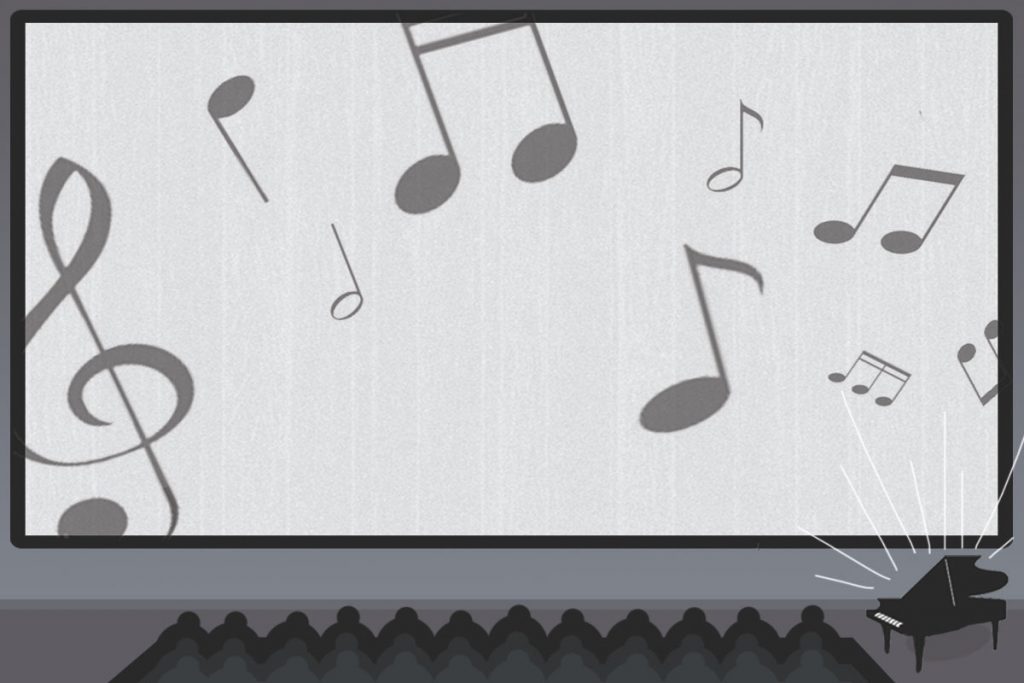The quiet conversations inside Theater 1 of the Gene Siskel Film Center slowly fade out as the lights dim. The audience settles in their seats while a man sitting on the far left side of the first row stands up and walks to a piano about five feet away from him.
The man bows as the filmgoers applaud. He then sits at his instrument as “Linda,” a 1929 picture directed by Dorothy Davenport, starts. The pianist breaks the silence with a folk melody that immediately transports the audience to the turn of the century, as the screen shows a bucolic cottage in the countryside.
For the next 73 minutes, David Drazin will add tension to a fistfight with dramatic chord progressions, evoke the young protagonist’s innocence with a high-pitched cantabile melody, and play some humorous ragtime to a boy’s attempt to take an extra piece of bread. He will completely improvise all of it.
“I’m not a memorizer, I‘m just an improv guy who can read better than average, and if I’ve never seen the movie before, I’ll just wing it,” he says a week after the screening during an interview at the Lake Shore Café in Hyde Park, where he sets up his keyboard for a Friday night gig with JJ and the Jazz Masters.
Drazin, 62, has been the silent film accompanist for The School of the Art Institute of Chicago’s (SAIC) Film Center since 1985, but his love for early 20th century cinema goes way back to his childhood. Of his childhood in Cleveland, OH, Drazin most clearly remembers watching scenes from Charlie Chaplin’s “The Adventurer” on television and listening to tons of music. His mother was a classical pianist, his father a collector of jazz records.
He bridged the worlds of music and cinema in an old-time movie club in high school, where he would buy 8-millimeter copies of films and project them, usually with a record player for the soundtrack. One time, a local library was showing “The Mark of Zorro,” a 1920 film starring Douglas Fairbanks, but there was no way of playing any records for it. There was, however, a piano next to the screen.
“I asked if I could try it out, and I did, so that was the first movie I played for,” he remembers. “I was a bit nervous at the beginning, but soon I got the hang of it. I loved to play the Spanish tinge with the big action scenes.”
Drazin, who majored in Jazz Studies at Ohio State University, usually researches the film to find out if it had original music released for it, and then rehearses it and incorporates it in his improvisations. His favorite moviesare the ones where he can really go wild.
“For instance, Fritz Lang’s ‘Metropolis’ is the perfect picture, because it’s in a future world, so you can do whatever you want. ‘Nosferatu’ is also a lot of fun. I was surprised one year when three different theaters in Chicago were showing it on Halloween, which is odd for a 1925 movie.”
Another fun challenge, he says, is foreign films. He remembers a festival honoring Japanese director Yazujiro Ozu, as well as a series of pre-Revolutionary Russian movies that were perfect, he says, for “emotional, spontaneous playing.”
Keeping the film’s pace is a skill he has put to the test several times. He has done a few marathons, playing, in a single day, two screenings of classics like Fred Niblo’s “Ben-Hur” or D. W. Griffith’s “Intolerance,” each one over two and a half hours long.
While he knows the audience is there for the film and not for him, he doesn’t agree with the idea that an accompanist should “disappear” and fade into the cinematic experience. Rather, he hides a few musical Easter eggs in hopes that a fellow privileged ear might find them.
“I played for Buster Keaton’s “The General” at the National Gallery in Washington, and I was playing the tune “Well You Needn’t” by Thelonious Monk in Harlem stride during a chase scene,” he said. “After it was over a gentleman came up to me very excited and said ‘You played Monk!’ I don’t expect anyone to notice, but when they do, it’s great.”
Films of the silent era, Drazin says, are a window to the past that allow modern audiences to breathe the air of their ancestors, especially in landscape shots, with no telephone wires in sight. However, he is grateful he does not live in this time period.
“Once I was reading a newspaper from 1912 that had a little article about a guy whose foot got stepped on by a horse, and because there were no antibiotics, his foot got infected, and he died, so it’s like, ‘Oh my God, this poor guy, no more jazz, no more movies, it’s all over!’ That’s probably what would happen to me. And if I did manage to survive that, I would lose my job by 1928 because the public demanded talkies.”





















